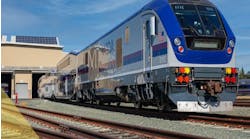MTA unveils new accessible station lab at Jay St-MetroTech Station
The Metropolitan Transportation Authority (MTA) opened the Jay Street-MetroTech A C F R Accessible Station Lab in downtown Brooklyn.
The new MTA living lab will test dozens of new features – new smartphone apps for wayfinding, floor treatments, braille and tactile maps, digital signage and in-station navigation – that make subway stations more accessible for riders of all abilities. The project will allow customers to test these products and services in a live station environment and provide direct feedback to New York City Transit (NYCT), while allowing NYCT to evaluate the durability and performance of such features. The pilot will run through Dec. 31, 2019.
"We all know that accessibility is about much more than elevators, and the Accessible Station Lab brings that idea to life,” said NYCT President Andy Byford. “Whether you use tactile guideways or an audio app to navigate, [or] benefit from our new customer information screens that provide service information in large, clear text or care about clean elevators, this project shows that the subway is for you."
The Jay St.-MetroTech Accessible Station Lab will demonstrate features that can further increase accessibility for customers with mobility-related disabilities, who are blind or low-vision, deaf or hard of hearing or have cognitive disabilities.
The features in the proof of concept include the following:
Physical Wayfinding
· Tactile Guideways: Blue guidance tiles with raised bars or domes throughout the main mezzanine and supporting braille signage at decision points. NYCT is testing different guideway materials including hard plastic and rubber to determine which customers prefer.
· Tape Guideways: Three different brightly colored tape guideways on the floor to indicate accessible and transfer paths, especially helpful for those with cognitive disabilities and forms of vision loss; plus, six boarding area floor markers.
· Stair Warnings: Fifty yellow warning strips with truncated domes at the top of stairs and colored tape at the bottom of stairs.
· Touch Graphic Maps: Interactive tablet map on the main mezzanine showing station environment; plus, tactile/braille line map on the R platform.
Five New Wayfinding Apps
· Waymap: Uses beacons at entrances, exits and around key features to guide users through station; uses audio and “smart routing” for those who are blind or low vision; available in multiple languages.
· NaviLens and NaviLens GO: More than 100 QR-style unique codes (on signage throughout station) to turn signs into audio that provide wayfinding, train arrival and trip planning. Navilens GO uses the same codes to create virtual arrows to help translate signs and guide users.
· AIRA: Service that connects users to trained live agents who provide digital descriptions to guide users to their destinations using a smart phone camera.
· Magnus Cards: Geared toward people with cognitive disabilities, each card deck provides step-by-step visual, audio and text instructions for navigating the station, using MetroCards, train rides and transfers and reading station maps and signs
· Click and Go Wayfinding: Large tactile station environment maps on mezzanines, dozens of pre-scripted audio routes provided via app with beacons for additional information and digital low-vision maps of routes throughout the station.
· New Customer Information Centers (CICs): Testing includes new ways to display escalator and elevator outage information to screens; information on Station Lab project.
· ADA Pathway Signage: There will be 15 alternate route diagrams that map alternate routes in the event of an elevator outage; and station layout diagrams that highlight the accessible path of travel from street to platform.
The Accessible Station Lab pilot is a milestone toward delivering on the Fast Forward goal to accelerate the rollout of accessibility features across the subway system. Those features that are deemed successful during the pilot, based both on customer feedback and operational performance, will be considered for inclusion in future ADA station projects, which are funded through the Capital Plan. MTA will also seek opportunities to integrate these features into its existing stock of accessible stations through innovative partnerships such as work with the Transit Tech Lab.
“It is so exciting to see what the MTA is doing at the Accessible Station Lab because they are using a range of high-tech and low-tech options to provide everyone equal access to information in the station,” said Gian Pedulla, member, NYCT Advisory Committee on Transit Accessibility. “This will help make the subway a more safe, efficient and comfortable means of transportation for blind users, and all riders with disabilities."
The full list of vendors participating in the project as well as a customer feedback section is available here (mta.info/accessibility/stationlab).
The 2020-2024 Capital Plan, recently approved by the MTA Board, includes a historic commitment of more than $5 billion to make an additional 70 subway stations ADA accessible, ensuring customers will be no farther than two stops from an accessible station anywhere in the system. The MTA says it has also made it a priority to improve communication with customers on the real-time status of elevators and escalators, improve audio and visual access to information throughout the system, and explore new approaches to priority and courtesy seating on buses.
The Accessible Station Lab will be on display until the end of 2019, and the MTA invites customers and advocates to visit the station during that time and provide feedback in-person or online. Engaging customers with disabilities, community members and advocacy organizations is a key element of the project.

